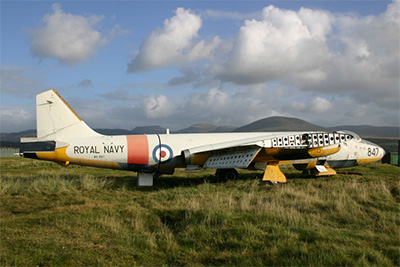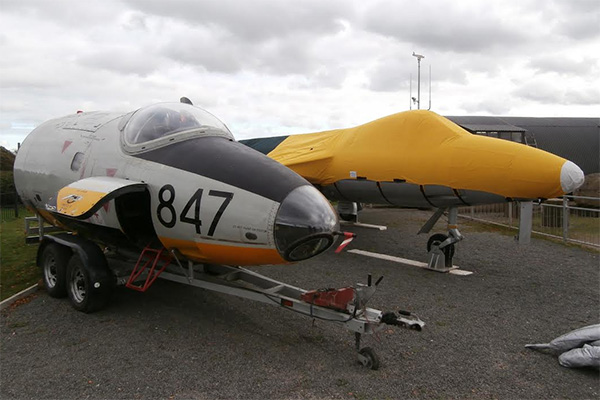WH887 is currently stored off-site but will return to Sywell in due course.
English Electric Canberra WH887 was built as a B.2 for the Royal Air Force, by Short Brothers at Belfast. It was delivered to the RAF on 29th January 1954, and was issued to 1323 Flight at RAF Wyton, which was primarily a Canberra PR.7 Unit. She was immediately thrown into action with two flights through H-bomb clouds during the American “Castle” thermonuclear bomb trials at Bikini and Eniwetok (now Enewetak) Atolls in May 1954. This was part of the thawing of nuclear relations between the US and UK, with the US permitting RAF air sampling of US bomb tests. In October 1955, 1323 Flt was merged with 542 Squadron, and WH887 was absorbed into the combined fleet as a result, moving with it to RAF Weston Zoyland. It was later transferred to 21 Squadron at RAF Upwood in Cambridgeshire, and also became part of the Station Flight. The aeroplane’s next confirmed movement took place on 31st October 1967, when it was ferried to Samlesbury from store at 15MU (Maintenance Unit) Wroughton for conversion to TT.18 status by English Electric. The process took over a year to complete, and it returned to RAF store, this time at RAF Shawbury in January 1969, in preparation for a service posting.

On 13th November 1969, WH887 was transferred to the Royal Navy but it did not immediately enter service, instead being held back in store at Shawbury. In November 1971, WH887 was moved to RAF Aldergrove in Northern Ireland to be prepared for service by 23MU, and three months later the aeroplane joined the Fleet Requirements Unit (FRU) at Hurn (now Bournemouth Airport). Assigned the fleet number ‘844’, WH887 was flown and maintained by civilian staff of Airwork Services Ltd. and was operated from Dorset until it was moved to RNAS Yeovilton on 24th November 1972. On 1st December 1972, the FRU merged with the Yeovilton-based Air Direction Training Unit (ADTU), and became the Fleet Requirements and Air Direction Unit (FRADU). WH887 was used by the Unit until it was moved to RAF St Athan in July 1974, for a major inspection and modifications, which would keep it on the ground for six months.

On 23rd January 1975, WH887 returned to the FRADU (the word training had been dropped from the Unit’s title) fleet as ‘844’, but this was soon changed to ‘847’. Two years of activity followed before another enforced grounding occurred in April 1977, when it was flown to Warton for a thorough refurbishment. Back in service in March 1979, the aeroplane spent time on loan with Flight Refuelling Ltd at Tarrant Rushton (June 1979-September 1980) and also at Hurn (November-December 1981) in between a steady period of FRADU service. Unfortunately the aeroplane was damaged by a bursting shell in February 1983, which required airframe repairs at St Athan later that month. Following the completion of the repairs, the aeroplane was given another major inspection, after which it was placed in long-term store.

On 21st February 1985, WH887 was re-introduced into service at Yeovilton, but again spent time away on loan from FRADU for trials work, this time at Salmesbury between April and May that year. At this time, the FRADU Canberra fleet was gradually being reduced, its work being taken over by specially modified civilian Falcon 20 business jets. Therefore, as the decade progressed the remaining airframes were rotated to prolong their airframe hours and fatigue lives and WH887’s turn in store at St Athan took place between November 1987 and February 1989. The aeroplane was one of the last three FRADU Canberras to retire from Fleet Air Arm service in November 1992.
The aeroplane then was ferried to the T&EE (Test and Evaluation Establishment) at Llanbedr airfield for storage on 3rd December 1992, and was used as a source of spares for the Station’s other airworthy Canberras. During 1997 it was moved into open store, perilously close to the fire dump, and remained there until 2004, when it was disposed of via tender due to the proposed closure of the airfield.
WH887, along with the other Canberras at Llanbedr were bought for scrap, but thankfully all three cockpit sections were saved and offered for sale by GJD Services Ltd. WH887’s cockpit was moved to a location near Basingstoke in Hampshire, where it was offered for onward sale.
During 2008, it was acquired by Sean Edwards and Matt Buddle, and they began to make preparations to take the aeroplane back to one of its former homes – RAF Upwood. On 24th August 2008, with the help of Historic Aero UK, the aeroplane was loaded onto a trailer and moved by road to its old haunt.

At Llanbedr being used for spares, shortly before scrapping 
Nose recovered from a scrapyard and delivered to former RAF Upwood 
10 months later – award winner at 2009 Cockpit Fest
By June of 2009, Sean and Matt had replaced her missing transparencies and panels and made good inroads into restoring the interior, taking her along to the Cockpit Fest event at Newark Air Museum and being awarded the Spirit of Cockpitfest award as a result of their hard work. Sean went on to work on another Canberra – WJ775 – leaving Matt to carry on with WH887.
By early 2014, Matt was thinking about moving ‘Cindy’ on, and as the Sywell Aviation Museum had been thinking about getting a cockpit exhibit for some time, Chairman Andrew Shemans and Secretary Ben Brown went along to inspect her. Immediately smitten, they bought her and Matt delivered her to Sywell on 25th October 2014.

She is in excellent shape, missing only a few instruments and with a few minor bits of skin damage that will be repaired in due course. She will retain her FRADU colours though her paint may be given a refresh when it becomes necessary. We would welcome any photos of her in service. If you worked on WH887 or flew her, or you have photos of her in service,we’d love to hear from you!